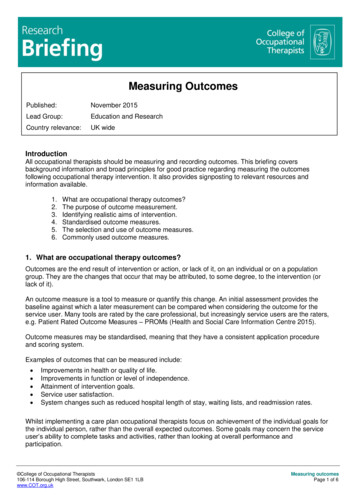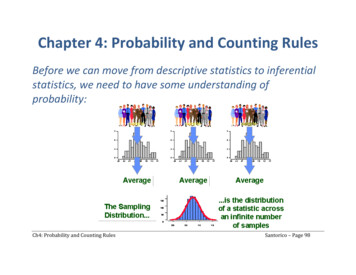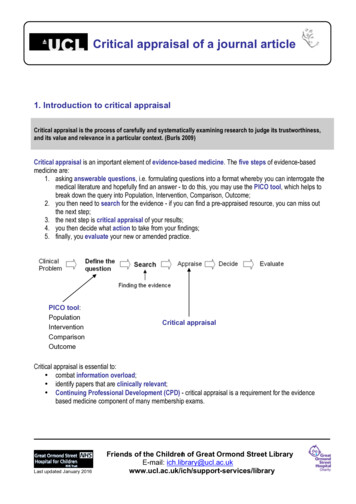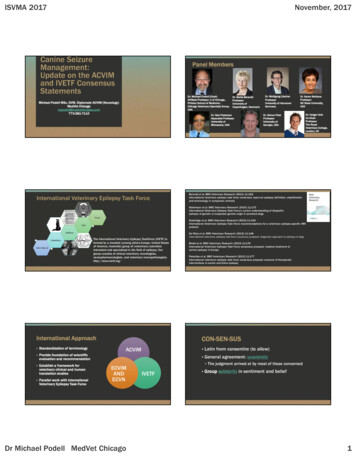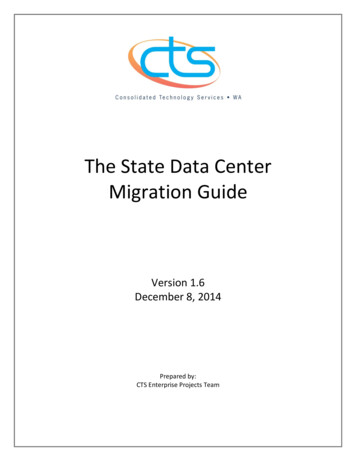
Transcription
International Journal of Pure and Applied MathematicsVolume 119 No. 17 2018, 1483-1492ISSN: 1314-3395 (on-line version)url: http://www.acadpubl.eu/hub/Special Issuehttp://www.acadpubl.eu/hub/Importance of Outcome Based Education (OBE) to AdvanceEducational Quality and enhance Global MobilityR.Nakkeeran1, R.Babu2, R.Manimaran3, P.Gnanasivam4Professor, Department of Computer Science and Engineering, Mahaveer Institute of Scienceand Technology, Hyderabad.2Professor, Department of Mechanical Engineering, Mahaveer Institute of Science andTechnology, Hyderabad.3Professor, Department of Mechanical Engineering, Karpagam College of Engineering,Coimbatore4Professor, Department of Electronics and Communication Engineering, Mahaveer Instituteof Science and Technology, Hyderabad.Email: sudhandhiram64@gmail.comABSTRACTIn the era of globalization, traditional education system is losing its relevance. In today’sworld, everything changes very rapidly and continuously. More skills are required to workwith very fast developing technology. The educational institutions should produce graduatesto cope with technological development. Thus to overcome the requirement, it is mandatoryto shift from traditional education system to Outcome Based Education (OBE), whichincludes Program Outcomes (PO), Program Specific Outcomes (PSO), and Course Outcomes(CO).Keywords:Outcome Based Education (OBE), Competence, Program Outcomes (PO), ProgramSpecific Outcomes (PSO), Course Outcomes (CO), Program Educational Objectives (PEO)1. IntroductionWith contrary to the fact that most teachers put the center of their attention too much onwhat they teach rather than on what their students learn, OBE emphasizes on what isexpected from the student to finally achieve when they complete their course rather than howthey achieved it. Outcome based education is defined as an approach to education in whichdecisions about the curriculum are driven by the outcomes the students should display by theend of the course- professional knowledge, skills, abilities , values and attitudes- rather thanon the educational process. It highlights the fact that you have to know the final destination ofyour journey before you start voyaging. Exploring new ways for designing tertiary educationis a worldwide pursuit. There is a need for tertiary education to provide both professionalknowledge/skills and all-round attributes to the graduates so as to enable them to face thediversified yet global demands of the 21st century society [1]. The attention now of differentinstitution of higher education in different nations is on students learning outcomes andassessment. The OBE comes in the form of competency-based learning standards andoutcomes-based quality assurance monitoring. OBE is being recognized as the mostimportant educational component of societies with knowledge based economy. OBEdesigned to achieve the predefined learning outcomes. OBE model of accreditation focuseson objectives and outcomes of an engineering programme. OBE starts with a clear picture ofwhat a student should be able to do, design the curriculum, teaching-learning process and11483
International Journal of Pure and Applied MathematicsSpecial Issueassessment to ensure that the outcomes are attained. OBE model facilitates ContinuousQuality Improvement (CQI) [2].2. Traditional Education systemThe traditional teaching style is often described as teacher-centered, lectures, curriculumcentered, and formal in other words transmitting information from the teacher to thestudent. The traditional learning provides the learner with knowledge or skills, or both, butthey are not coupled to a specific context – so the learning takes place in a vacuum andcannot be regarded as outcomes-based learning. It belongs to the input part of the learningprocess.2.1. Deficiencies of Traditional Education system It was a rigidly structured curriculum process without any stakeholder participation inthe decision-making process. It laid an emphasis on academic education which resulted in the development ofskills being neglected. It was an inflexible and prescriptive curriculum. It was norm-referenced whereby learner achievement was compared to that of otherlearners and this resulted in excessive competition. There is a gap between formal education and training for a career. Testing of learner achievement in terms of symbols or marks were often not a truereflection of the learner’s actual performance. The emphasis was on differentiation in the form of a broad variety of subjects. A teacher-centered, rather than a learner-centered classroom approach, was applied. It was a content-based curriculum whereby the teacher instructed and the learnermemorized. Lack of collaboration and group learning Improper alignment between objectives, activities and assessments Lack of emphasis on soft skills needed in jobs like communication skills interpersonal skills analytical skills working attitude etc.2.2 Outcome-Based Education (OBE)To compete in a global economy in a highly technological era, a country requires aworkforce that: can solve problems is committed to ongoing learning is creative has above-average communication skills is in line with new technological developments is flexible can participate in management processes and decision-making and can work interactively.OBE is a flexible, empowerment-oriented approach to learning. It aims at equippinglearners with the knowledge, competence and orientations needed for success after they leaveinstitution. Hence its guiding vision is that of a competent future citizen. Success at educationinstitution level is of limited benefit unless learners are equipped to transfer academic successto life in a complex, challenging, high-technology future. OBE deals with the input- as well1484
International Journal of Pure and Applied MathematicsSpecial Issueas the output processes [3]. The key principle of OBE states that all activities (teaching,assessment, etc.) are geared towards, not what the teacher is going to teach, but what theoutcome of that teaching should be, what the learner is supposed to do and at what standard.2.3 Definition of Outcomes-based EducationOBE is a comprehensive approach to organizing and operating a curriculum that isfocused on and defined by the successful demonstrations of learning sought from eachlearner. The term clearly means focusing and organizing everything in an education systemaround “what is essential for all learners to be able to do successfully at the end of theirlearning experiences”. OBE ultimately implies emerging with a vivid idea of what isimportant for learners to be able to do (determining the outcomes), thereafter developing theprogrammes for learning, implementing it and assessing the learner on a continuous basis toensure that learning has ultimately taken place. The outcomes-based approach to educationrequires [4]: Developing a clear set of outcomes organized into the system’s subjects and Establishing conditions and opportunities within the system to enable andencourage learners to achieve these outcomes.2.4 The Shift from Content-based Education to Outcome-based EducationThe aim of education is to prepare learners for life in society and for performing tasks. Itis the intention of the outcomes-based approach to focus as much on the process of learningand the final outcome or result, as on the knowledge and skills. In this way, the process ofachieving outcomes during the process of learning can be related directly to the way in whichoutcomes are achieved in the world of work [5]. The outcomes-based approach requires amind shift in the curriculum process and the way in which the learner should be empoweredfor the achievement of outcomes.Table1. Comparison of Traditional and Outcome based educationTraditionalOBELearners are passive.Learners are activeThe approach is exam-driven.Learners are assessed on an ongoing basis.Rote-learning is encouraged.Critical thinking, reasoning, reflection andaction are encouraged.The syllabus is content-based and divided Content is integrated and learning is relevantinto subjects.and connected to real-life situationsLearning is textbook/worksheet-bound and Learning is learner-centered, the teacherteacher-centeredfacilitates and constantly applies group workand team work to consolidate the newapproach.The teacher sees the syllabus as rigid and non Learning programmes are seen as guides thatnegotiable.allow teachers to be innovative and creativein designing their programmes.Teachers are responsible for learning and Learners take responsibility for their ownmotivation depends on the personality of the learning and are motivated by feedback andteacher.affirmation of their worth.The purpose of OBE is to increase the knowledge and skills of the learners. Byintroducing OBE, opportunities may arise for people who’s academic or career paths werestifled due to their prior knowledge not being assessed and certified, or because theirqualifications had not been recognized for admission to further learning and employment.1485
International Journal of Pure and Applied MathematicsSpecial Issue2.5 Focus and Benefits of OBE2.5.1 OBE addresses the following key questions: What do we want the students to have or be able to do? How can we best help students achieve it? How will we know whether they students have achieved it? How do we close the loop for further improvement (Continuous Quality Improvement(CQI))?2.5.2 Benefits of OBE:1. More directed & coherent curriculum.2. Graduates will be more “relevant” to industry & other stakeholders (more wellrounded graduates)3. Continuous Quality Improvement (CQI) is in place.OBE shifts from measuring input and process to include measuring the output (outcome).Figure 1: OBE System [6]2.6 Origin of OBE It is an International Partnership In 1989 the six foundation signatory organizations from Australia, Canada, Ireland,New Zealand, the United Kingdom and United States observed that their individualprocesses, policies, criteria and requirements for granting accreditation to universitylevel programmes were substantially equivalent. They agreed to grant (or recommendto registering bodies, if different) the same rights and privileges to graduates ofprogrammes accredited by other signatories as they grant to their own accreditedprogrammes. Full signatories as of 2017 are Australia, Canada, Ireland, New Zealand, UnitedKingdom, United States , Hong Kong China , South Africa , Japan , Singapore ,Korea, Malaysia, Turkey, Russia The following organizations hold provisional status:Bangladesh, China, India, Pakistan, Philippines, Sri Lanka2.7 Outcome sequenceThe outcome of a programme may be accessed at different periods of study. But theoutcomes at all levels are not mandatory. One or two levels are merged and cumulative1486
International Journal of Pure and Applied MathematicsSpecial Issueassessment may be enough. But the assessment must give significant scale value tomeasure the outcome at various levels [7].Exit OutcomesProgramme OutcomesCourse OutcomesUnit OutcomesLesson OutcomesFigure 2: Outcome sequenceFor example, programme outcomes, course outcomes may be the sufficient indicator ofquality of outcome at the end of graduation period and course period respectively.2.8 OBE FrameworkThe OBE Framework is a paradigm shift from traditional education system into OBE systemhere there is greater focus on program and course outcomes. Also for the educational systemto function effectively, OBE framework is identified. It guarantees that curriculum, teachingand learning strategies, and assessment tools are continuously enhanced through anevaluation process.OBE FrameworkFigure 3: OBE Framework1487
International Journal of Pure and Applied MathematicsSpecial IssueThe OBE framework as shown in the figure [8].OBE Implemented with the following components Vision, and Mission PEOs POs Cos3. Program Educational Objectives (PEOs).Program Educational Objectives (PEO) is defined as qualities or specific goals describingexpected achievements of graduates in their career and professional life after graduation.These objectives are aligned with the vision-mission statement of the department and aredefined in collaboration with the stakeholders from the industry partners, students, parents,alumni, faculty and administration [9&10].The PEOs will be assessed three (3) to five (5)years after the students graduated from college through a tracer study and employersquestionnaire surveys. The data obtained from the assessment will be used as basis for theimprovement of the existing PEOs.3.1 Program Outcomes (PO)At the heart of OBE are the Graduate Attributes. The Graduate Attributes, alsoreferred to as Program Outcomes, stated in Washington Accord, which are givenbelow [11].1. Engineering knowledge: Apply the knowledge of mathematics, science, engineeringfundamentals, and an engineering specialization to the solution of complex engineeringproblems.2. Problem analysis: Identify, formulate, research literature, and analyze complexengineering problems reaching substantiated conclusions using first principles ofmathematics, natural sciences, and engineering sciences.3. Design / development of solutions: Design solutions for complex engineering problemsand design system components or processes that meet the specified needs withappropriate consideration for the public health and safety, and the cultural, societal, andenvironmental considerations.4. Investigation: Use research-based knowledge and research methods including designof experiments, analysis and interpretation of data, and synthesis of the information toprovide valid conclusions5. Modern tool usage: Create, Select, and apply appropriate techniques, resources, andmodern engineering and IT tools including prediction and modeling to complexengineering activities with an understanding of the limitations.6. The Engineer and Society: Apply reasoning informed by the contextual knowledge toassess societal, health, safety, legal and cultural issues and the consequent responsibilitiesrelevant to the professional engineering practice.7. Environment and sustainability: Understand the impact of the professional engineeringsolutions in societal and environmental contexts, and demonstrate the knowledge of, andneed for sustainable development.8. Ethics: Apply ethical principles and commit to professional ethics and responsibilitiesand norms of the engineering practice.9. Individual and team Work: Function effectively as an individual, and as a member orleader in diverse teams, and in multidisciplinary settings10. Communication: Communicate effectively on complex engineering activities with theengineering community and with society at large, such as, being able to comprehend and1488
International Journal of Pure and Applied MathematicsSpecial Issuewrite effective reports and design documentation, make effective presentations, and giveand receive clear instructions.11. Project management and finance: Demonstrate knowledge and understanding of theengineering and management principles and apply these to one’s own work, as a memberand leader in a team, to manage projects and in multidisciplinary environments12. Life-long learning: Recognize the need for, and have the preparation and ability toengage in independent and life-long learning in the broadest context of technologicalchange.3.2 OBE Framework mappingsAll courses under the academic programme would have their own course outcomes oralso commonly known as CO. These COs are produced based on the requirement of theprogramme outcomes (PO). Each CO will be mapped to PO (the CO-PO) matrix. The POwill be then mapped to the programme educational objectives (PEO) [11 & 12]. Figure 1shows an example of relationship between CO, PO and 8PO4PO9CO4CO9PO5PO10PO7PEO2PEO3PEO4Figure 4: OBE Framework mapping.Once the outcomes for a course have been identified, the assessment methods need tobe designed in such a way to achieve the stated outcome. Assessment is important to assesswhether the student or learner has attained what is expected out of them. The result fromthese will be used for continuous quality improvement (CQI). Suitable assessment methodneeds to be chosen, depending on the expected course outcome.3.3 OBE AssessmentAssessments can provide direct or indirect measures of student learning. Direct measures require students to demonstrate their achievement and ofteninvolve quantitative measurement procedures. Indirect assessment is based on opinions.Direct evidence of student performance or attainment relies upon direct scrutiny orexamination of student performance or attainment for individual students. These methodsallow you to collect the evidence of student learning or achievement directly from studentsand the various works they submit to you (assignment, exam, term paper, project, LaboratoryTests, Quizzes and etc.)[13&14].Indirect evidence of student achievement requires thatfaculty infer actual student abilities, knowledge, and values rather than observe direct1489
International Journal of Pure and Applied MathematicsSpecial Issueevidence of learning or achievement. Indirect methods provide the perspectives of students,faculty or other people who are concerned with the course or program or institution, such asalumni.3.4 Attainment of Outcomes:The process of attainment of COs, POs and PSOs starts from writing appropriate COsfor each course of the program from first year to the period of the program. The courseoutcomes are written by the respective faculty member. Then, a correlation is establishedbetween COs and POs in a fixed scale value for example, 1 being the slight (low), 2 beingmoderate (medium) and 3 being substantial (high). A mapping matrix is prepared in thisregard for every course in the program. The overall attainment of outcomes of a program(POs) is computed by adding direct attainment and indirect attainment values in a fixedproportion and compared with the set value. Any deviations from the set value, then thesystem should be improved so that to reach the set value. This should be done continuouslytill the attainment of set value. This is called the continuous improvement and also thestrength of the OBE [15 &16].4. ConclusionThis paper provides an overview of the key characteristics of Outcomes-BasedEducation and its application in various contexts. The approach is based on sound educationalprinciples and provides a robust framework for students to acquire the necessary fitness topractice. The level of educator’s understating of OBE is still very low. For successfulimplementation of OBE, the educators should understand the OBE system. All of sudden thetraditional approaches should not be thrown away, but should be used as a means towardsimplementing OBE. Educators should change or improve their ways of instructing andaccessing the learner’s work. Affiliating universities should frame the curriculum, studentsassessing system (Examination question pattern) and teaching methodologies in such a waythat the students should realize the importance of OBE system. It is necessary to find methodsto implement the twelve graduate attributes individually in a successful manner. Also theentire academic institutions in the nation should follow the common way of producing thegraduates following the OBE system. Then only the importance of OBE can be realized.References[1]. Michael J. Lawson and Helen Askell-Williams, "Outcomes-based education", discussionpaper, 2007[2]. Spady, William G. Outcome-Based Education: Critical Issues and Answers.[3]. Bloom B. Learning for mastery. Eval Com 1(2): 1968.[4]. Spady WG. Outcome-Based Education. ACSA report no 5. Belconnen: pii AustralianCurriculum Studies Association, 1993.[5]. Stephen E. RulYn and William G. Spady, (1984) "Achieving Excellence ThroughOutcome-Based Instructional Delivery," Educational Leadership.[6]. Douglas E. Mitchell and William G. Spady, (1978) "Organizational Contexts forImplementing Outcome-Based Education," Educational Researcher.[7]. O’Neil J. Aiming for new outcomes: The promise and the reality. Educ Leadersh 51(6),1994.[8]. McNeir G. Outcome-based education: Tools for restructuring. Oregon School StudyCouncil Bulletin 36(8), 1993.[9]. Harden RM, Crosby JR, Davis MH. An introduction to outcome-based education. MedTeacher 21(1), 1999.1490
International Journal of Pure and Applied MathematicsSpecial Issue[10]. Acharya, C. Outcome-based education (OBE): A new paradigm for learning. Centre forDevelopment of Teaching and Learning (Singapore), 2003.[11]. International Engineering Alliance, 25 Years of the Washington Accord[12].Bouslama, F., Lansari, A., Al-Rawi, A., & Abonamah, A. A. A novel outcome-basededucational model and its effect on student learning, curriculum development, andassessment. Journal of Information Technology Education, 2003.[13]. Bloom, B. S. (1956). Taxonomy of Educational Objectives, Handbook I: The CognitiveDomain. New York: David McKay Co Inc.[14]. Anderson, L. W., and Krathwohl, D. R. (2001). A taxonomy for learning, teaching, andassessing, Abridged Edition. Boston, MA: Allyn and Bacon.[15]. Mehdi, Riyadh A. K.; AbouNaaj, Mahmoud S. (2013) Academic Program Assessment:A Case Study of a Pragmatic Approach, Creative Education Vol.4, No.1, 71- 81[16]. Ashley Kranov, Michael Milligan, Joe Sussman.(2011) Dispelling Myths: CommonMisconception about ABET and Accreditation, ABET Annual Conference.1491
1492
Importance of Outcome B ased E ducation (OBE) to Advance Educational Quality and enhance Global Mobility R.Nakkeeran 1, R.Babu 2, R .Manimaran 3, P.Gnanasivam 4 1Professor, Department of C omputer S cience and E ngineering , Mahaveer Institute of Science and Technology, Hyderabad.

